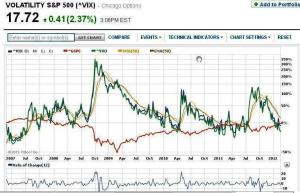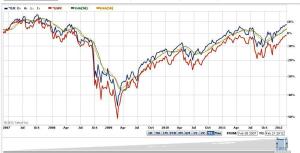Even if the WSJ is a bit slow on the uptick re: noticing the recent anomaly in VIX skew volatility that we commented on last week, Chris Dieterich’s WSJ weekend story, “Surge in FIX Futures Volumes Driven By Bigger Risk Appetites” makes note of the fact that last month’s daily trading volume of VIX futures on the CBOE’s Volatility Index was the second highest on record, despite what some trading desks viewed as lackluster overall volumes.
More interesting than the volume spike is the gap between the VIX and near-term futures; the April contract is up 2.2% over the last month and on Friday ended at 23.65. The VIX index closed at 17.29, up 0.2% on the day.
On its face, strategists said this unusually wide gap appears to be a warning sign of an increase in market volatility ahead, as traders pay a higher premium to protect against risk further out. Historically, when VIX futures trade this much above the VIX, a modest rise in stocks follows. That has happened 36 times since 2004, and, on average, the S&P 500 traded about 1% higher 50 days after the initial signal, according to data from Schaeffer’s Investment Research.









 Observed option market pro David Beth, the Pres/COO of institutional options and ETF broker WallachBeth Capital, ” Its good [for investors] to have more options, no pun intended. The fund industry’s limited use of the most conservative option-related strategies has always been a “head-scratcher” for those who have lived through multiple market cycles over the years and always perceived that big funds are obliged to use conservative strategies. Regardless of where one thinks the market is headed in the short or medium term, these new funds illustrate the growing recognition that systematic covered call writing can cushion downside exposure and enhance portfolio returns in both low-interest rate and stagnant market cycles; especially for funds with conservative mandates.”
Observed option market pro David Beth, the Pres/COO of institutional options and ETF broker WallachBeth Capital, ” Its good [for investors] to have more options, no pun intended. The fund industry’s limited use of the most conservative option-related strategies has always been a “head-scratcher” for those who have lived through multiple market cycles over the years and always perceived that big funds are obliged to use conservative strategies. Regardless of where one thinks the market is headed in the short or medium term, these new funds illustrate the growing recognition that systematic covered call writing can cushion downside exposure and enhance portfolio returns in both low-interest rate and stagnant market cycles; especially for funds with conservative mandates.” 

